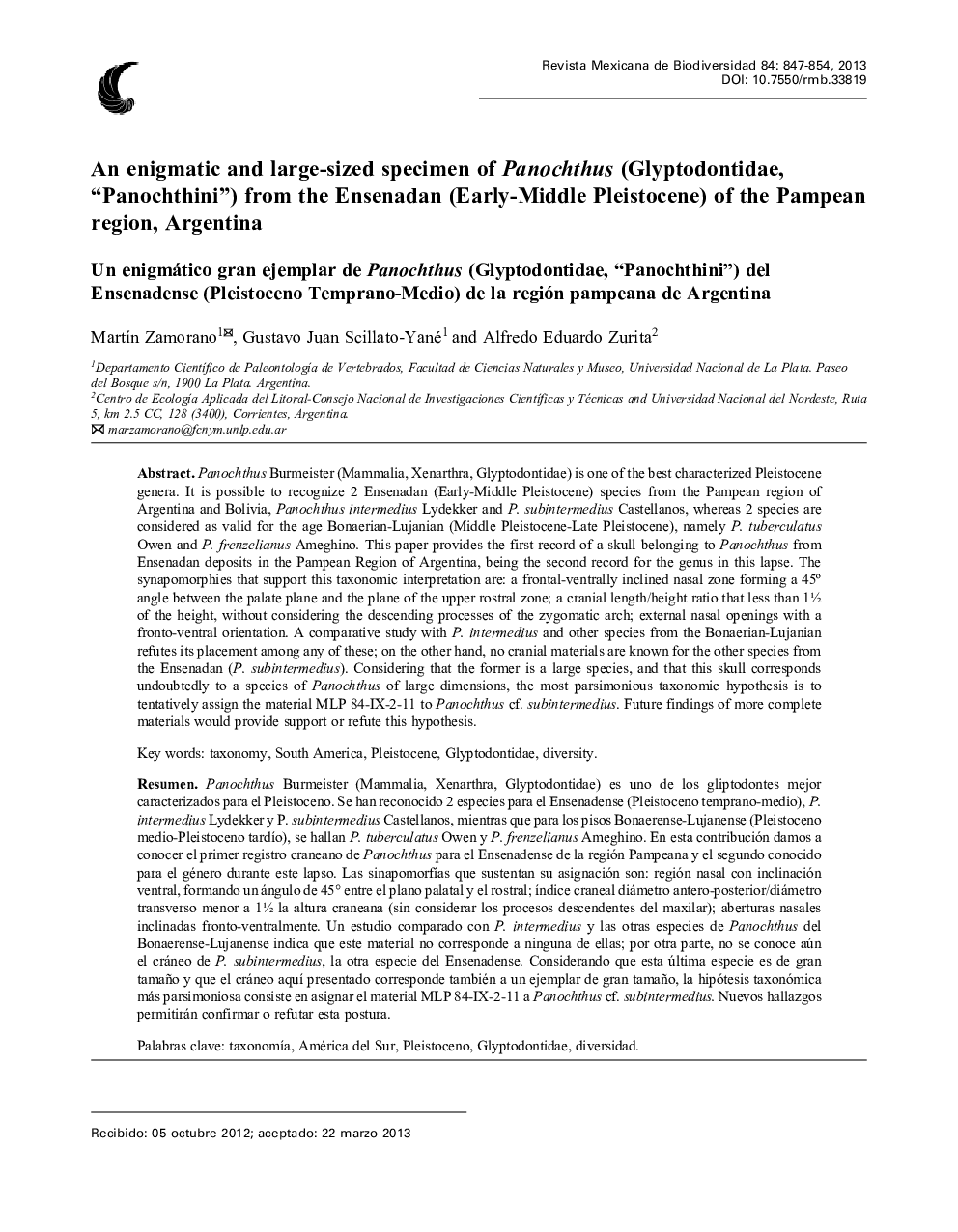| کد مقاله | کد نشریه | سال انتشار | مقاله انگلیسی | نسخه تمام متن |
|---|---|---|---|---|
| 4461817 | 1313405 | 2013 | 8 صفحه PDF | دانلود رایگان |

Panochthus Burmeister (Mammalia, Xenarthra, Glyptodontidae) is one of the best characterized Pleistocene genera. It is possible to recognize 2 Ensenadan (Early-Middle Pleistocene) species from the Pampean region of Argentina and Bolivia, Panochthus intermedius Lydekker and P. subintermedius Castellanos, whereas 2 species are considered as valid for the age Bonaerian-Lujanian (Middle Pleistocene-Late Pleistocene), namely P. tuberculatus Owen and P. frenzelianus Ameghino. This paper provides the first record of a skull belonging to Panochthus from Ensenadan deposits in the Pampean Region of Argentina, being the second record for the genus in this lapse. The synapomorphies that support this taxonomic interpretation are: a frontal-ventrally inclined nasal zone forming a 45° angle between the palate plane and the plane of the upper rostral zone; a cranial length/height ratio that less than 1% of the height, without considering the descending processes of the zygomatic arch; external nasal openings with a fronto-ventral orientation. A comparative study with P. intermedius and other species from the Bonaerian-Lujanian refutes its placement among any of these; on the other hand, no cranial materials are known for the other species from the Ensenadan (P. subintermedius). Considering that the former is a large species, and that this skull corresponds undoubtedly to a species of Panochthus of large dimensions, the most parsimonious taxonomic hypothesis is to tentatively assign the material MLP 84-IX-2-11 to Panochthus cf. subintermedius. Future findings of more complete materials would provide support or refute this hypothesis.
ResumenPanochthus Burmeister (Mammalia, Xenarthra, Glyptodontidae) es uno de los gliptodontes mejor caracterizados para el Pleistoceno. Se han reconocido 2 especies para el Ensenadense (Pleistoceno temprano-medio), P. intermedius Lydekker y P. subintermedius Castellanos, mientras que para los pisos Bonaerense-Lujanense (Pleistoceno medio-Pleistoceno tardío), se hallan P. tuberculatus Owen y P. frenzelianus Ameghino. En esta contribución damos a conocer el primer registro craneano de Panochthus para el Ensenadense de la región Pampeana y el segundo conocido para el género durante este lapso. Las sinapomorfías que sustentan su asignación son: región nasal con inclinación ventral, formando un ángulo de 45° entre el plano palatal y el rostral; índice craneal diámetro antero-posterior/diámetro transverso menor a 1% la altura craneana (sin considerar los procesos descendentes del maxilar); aberturas nasales inclinadas fronto-ventralmente. Un estudio comparado con P. intermedius y las otras especies de Panochthus del Bonaerense-Lujanense indica que este material no corresponde a ninguna de ellas; por otra parte, no se conoce aún el cráneo de P. subintermedius, la otra especie del Ensenadense. Considerando que esta última especie es de gran tamaño y que el cráneo aquí presentado corresponde también a un ejemplar de gran tamaño, la hipótesis taxonómica más parsimoniosa consiste en asignar el material MLP 84-IX-2-11 a Panochthus cf. subintermedius. Nuevos hallazgos permitirán confirmar o refutar esta postura.
Journal: Revista Mexicana de Biodiversidad - Volume 84, Issue 3, September 2013, Pages 847–854